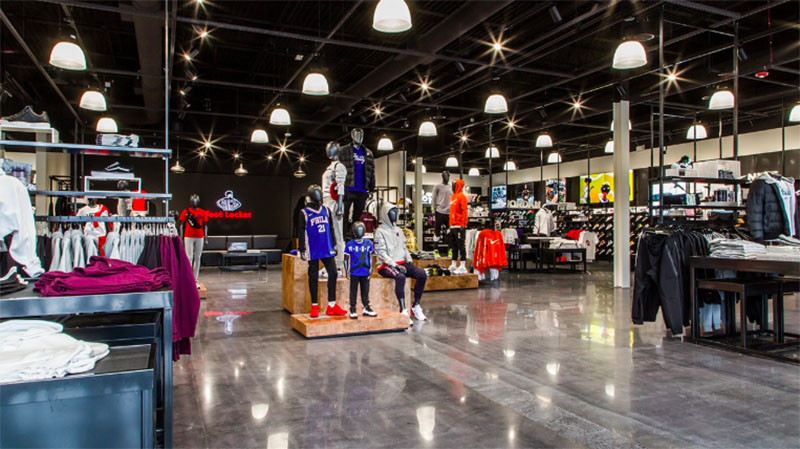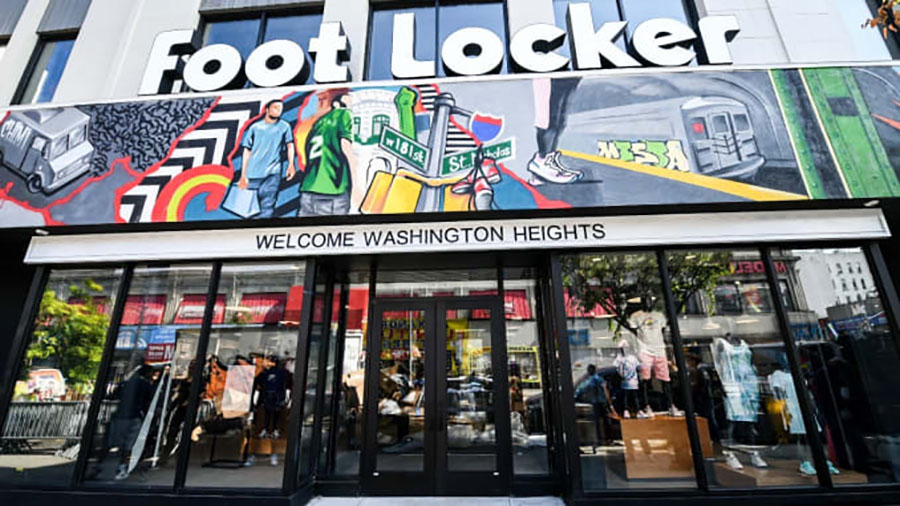By Thomas J. Ryan
<span style="color: #999999;">Foot Locker Inc. on Friday reported third-quarter earnings that topped analysts’ estimates on a 5.7 percent same-store gain and improving gross margin and SG&A rates. But shares of the sneaker juggernaut fell Friday as it gave a disappointing outlook for the holiday season due to the timing of launches and struggles in apparel.
Foot Locker now expects to report flat fourth-quarter comparable-store sales compared with a 9.7 percent gain last year and a 2 percent increase that Wall Street analysts were expecting. Foot Locker also reduced its EPS guidance for the year.
Shares of Foot Locker eased $1.22 to $40.24 Friday in trading on the New York Stock Exchange.
In the quarter ended November 2, net earnings reached $125 million, or $1.16 per share, down from $130 million, or $1.14, a year ago. The current year included a $4 million gain in connection with the acquisition of a Canadian distribution center lease and related assets and a $1 million charge related to a pension matter.
Excluding these items, non-GAAP EPS improved 18.9 percent to $1.13 from 95 cents excluding non-recurring items in the year-ago period. Wall Street’s consensus estimate had been $1.08.
The quarterly comp gain of 5.7 percent came on top of a 2.9 percent year-ago gain and above analysts’ consensus estimate of 4.7 percent. By month, comps grew high-single-digits in August and September to support a “very strong” back-to-school season, said Lauren Peters, EVP and CFO, on a conference call with analysts. October showed a low single-digit comp increase.
Net sales increased 3.9 percent, to $1.93 billion, just shy of analysts’ estimates of $1.94 billion. On a currency-neutral basis, net sales climbed 5.1 percent.
By channels, Direct-to-Consumer (DTC) expanded 11.4 percent to reach 15.3 percent of sales for the quarter, up from 14.5 percent a year ago. Store channel sales increased 4.7 percent.
<span style="color: #999999;">Almost all divisions performed well during the quarter. In North America, Foot Locker Canada led the way, once again, with its second consecutive low-double-digit comp gain. Champs Sports, Foot Locker U.S. and Kids Foot Locker each delivered a high single-digit comp gain. Foot Action increased low-single-digits. Internationally, Foot Locker Pacific posted its fourth consecutive double-digit increase. Foot Locker Europe and the Runners Point Group each produced a low single-digit increase. East Bay was the only division to post a decline, off high-single digits.
Among categories, footwear was up high-single-digits, while apparel and accessories together were down high-single-digits. Footwear strength was broad-based, with men’s comps up high-single-digits, women’s up mid-single-digits, and kids up double-digits. Double-digit growth in men’s basketball and mid-single-digit gains in men’s running were key drivers. Growth in women’s was fueled by classic basketball and court style.
“The back-to-school period demonstrated the strong connections we have with our younger customers and their parents,” added Peters. “The terrific performance in kids’ footwear was even broader, with strong growth in almost every one of our divisions and fueled by strength across grade-school, pre-school and infant sizes with double-digit gains in basketball and running and positive results in casual silhouettes.”
Apparel remained challenging, down high-single-digits; however, Foot Locker Canada and Foot Locker Pacific each benefited from double-digit gains in apparel. At Foot Locker U.S., women’s apparel business was up double-digits. In Europe, kids’ apparel delivered a double-digit gain.
 Elaborating on sales highlights for the quarter, Dick Johnson, chairman, president and CEO, noted that the basketball category returned to growth. The performance was fueled by a strong Jordan business led by the classic AJ 1s in the retailer’s exclusive Jordan Rivals pack combined with robust demand for Air Force 1s from Nike and the Adidas Hardcourt. Signature basketball had “some bright spots” with strong performances from Giannis and Kyrie from Nike. Running’s “solid results” were driven by lifestyle running models, including AirMax from Nike, Easy and NMD from Adidas, and the Puma RSX.
Elaborating on sales highlights for the quarter, Dick Johnson, chairman, president and CEO, noted that the basketball category returned to growth. The performance was fueled by a strong Jordan business led by the classic AJ 1s in the retailer’s exclusive Jordan Rivals pack combined with robust demand for Air Force 1s from Nike and the Adidas Hardcourt. Signature basketball had “some bright spots” with strong performances from Giannis and Kyrie from Nike. Running’s “solid results” were driven by lifestyle running models, including AirMax from Nike, Easy and NMD from Adidas, and the Puma RSX.
A number of concept collaborations also paid off, including the Swoosh Collection with Nike, the Jordan Rivals pack and the Logo Distortion collection with Adidas.
Apparel was impacted by a fashion shift away from select branded sportswear programs that had driven growth in recent quarters. Also hurting the apparel category was the retailer’s strategic move away from private label and tough comparisons in the licensed category.
Eastbay’s decline continued to reflect softer results across performance footwear and apparel. The current style shift in casual apparel away from wind wear and nylon was also negative for Eastbay.
“We are working to improve performance and did see some bright spots, especially in the basketball category,” said Johnson. “Looking forward, we have an exciting lineup for this holiday season.”
He cited the next iteration of the Swoosh Collection from Nike, the new Kyrie 6 launch and expected continued strength in Jordan and Air Force 1s. The next update of the Logo Distortion from Adidas will arrive as well as some Yeezy drops. Significant launches from Timberland, Champion and Puma are also expected to support holiday selling.
<span style="color: #999999;">Store traffic was unchanged in the quarter, down low-single-digits overall, while conversion improved. Traffic gains were seen at Foot Locker Pacific, Foot Locker Canada and Sidestep. Average selling prices rose high-single-digits, while units were down low-single-digits, primarily due to a decline in apparel penetration.
Gross margins in the quarter expanded 50 basis points to 32.1 percent. A 10 basis point reduction in merchandise margin, due to the softer apparel trends, initial mark-up mix and the higher penetration of DTC, was offset by sales leverage on relatively fixed occupancy and buyers compensation.
SG&A expenses improved 10 basis points to 21.3 percent due to both disciplined expense management and the strong top-line performance.
Inventories were 0.6 percent lower. Using constant-currencies, inventory increased by 0.5 percent. Said Peters, “Our turns continued to improve overall, and our inventory remains both fresh and productive heading into the holiday season.”
Elaborating on its four strategy initiatives, Johnson said the company made progress with its goal of Elevating The Customer Experience by finding success with its larger, community-driven Power Stores concept. A recently-opened Power Store in New York’s Washington Heights is delivering significant gains in traffic, conversion and overall satisfaction. Two more Power Stores opened in the quarter in Melbourne, Australia and Frankfurt, Germany.

Tests of the membership program FLX show its driving stronger enrollment and metrics compared to the old VIP program. FLX is expected to roll out in the U.S. post-holiday. At the store level, Foot Locker Europe is rolling out enhanced Nike and Jordan presentations to support elevated storytelling. Enhanced women’s spaces are being introduced in select European and U.S. markets.
Regarding its second strategic priority, Investing In Long-Term Growth, the launch of its in-house incubator Greenhouse has led to partnerships with emerging designers Nicole McLaughlin and Christina Paik as well as a collaboration between Atmos, Adidas, and popular media and music conglomerate 88rising at complex.com. The company also in September announced its investment in NTWRK, a video-based shopping app that works with celebrities and brands to sell limited-edition merchandise.
Progress on its third strategic initiative, Driving Productivity, was marked digital and analytics investments improving personalization. Said Johnson, “Initial results from these efforts show that personalization, even as simple as directing customers to their preferred store or offering them the latest release from their favorite brand or model, allows us to deliver an improved, more relevant, customer experience and to employ a more efficient marketing spend while driving top-line results.”
Finally, the fourth imperative, Leveraging The Power Of Our People, is expected to be aided by the launch of Lace Up, a new associate learning and communications platform.
<span style="color: #999999;">For the fourth quarter, Foot Locker expects comps to be relatively flat, which reflects the sluggish trends in apparel business as well as the challenging comparison to last year’s 9.7 percent comp gain. Gross margins are expected to decrease 10 to 30 basis points, SG&A rate is expected to be flat to up 10 basis points and EPS expected to expand mid- to high-single-digits.
For the full-year, comp sales are projected to be up in the low-single-digit range with gross margin improvement of 10 to 20 basis points. SG&A is projected to be up 40 basis points to 50 basis points as a percent of sales and EPS is expected to expand mid-single-digits. Previously, Foot Locker expected a mid-single-digit comp gain. Gross margin guidance remains the same. SG&A was expected to be up 30 to 50 basis points. EPS had been expected to increase high-single-digits.
Peters also said that starting with the first quarter, the company will shift to providing only annual comp sales and EPS outlook and not detailed quarterly guidance. Peters said, “We believe this approach is aligned with our long-term thinking, reflects how we manage the business and is consistent with current best practices.”
In the Q&A session, many of the questions focused on weaker comp guidance.
Johnson elaborated that the company had long known it would face tough comparisons against last year’s 9.7 percent comp. The year-ago strong comp was boosted by Adidas’ decision to expand the Yeezy collection across price points. The timing of Yeezy drops for this year, as expected, were more spread out this year between the third and fourth quarters but the timing of those drops was “different than we expected” to partly lead to the comp adjustment.
Johnson also said the headwinds in apparel were “a little bit more severe than I expected,” and he pointed to the challenges at Eastbay as a third factor in the lower comp guidance.
The CEO still expressed confidence in the business, particularly in the chain’s core footwear offerings. Said Johnson, ‘I feel good about where our footwear businesses are. There’s always puts and takes. We see some models and some categories slow down a little bit. We see others accelerate. They don’t always line up perfectly. But, I think, putting even a little bit on a 9.7 percent comp over a two-year period is a great reflection on the good work that the team has done.”
















